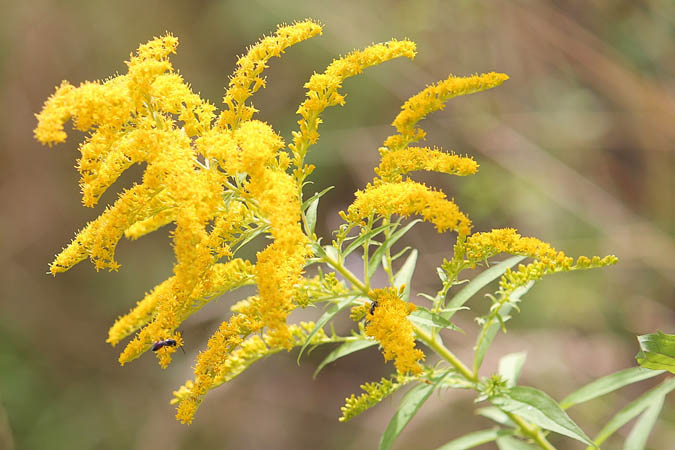Goldenrod gets a bad rap, but there are tons of reasons to love it—from its use as a tea to all the ways it heals.

A hint of color in the leaves, the smell of hay bales, that first hint of crispness in the air, and the royal glow of goldenrod. These are the whisperings of nature: “Something is coming.”
Goldenrod signals the change of seasons. It appears in mid- to late-summer and journeys with us into fall. It’s a burst of color, an accent of beauty for a landscape in transition, and a good last-minute food source for bees as they prepare for colder weather.
You May Also Enjoy:
Check Out TGN’s Collection of Premium-Quality Herbs!
“How to Not Die While Wildcrafting: 15 Rules for Foraging Safely”
Goldenrod’s exact timing will vary with your location and the species that are common around you. But I appreciate the sentiment whenever it arrives. This rod of gold may be a weed to some, even the target of scorn, but to me it’s a favorite part of the season and a friend returning after a long sojourn.
Panning for Goldenrod
Most goldenrod species are native to North America, though other native species do exist elsewhere and are common throughout North Africa, Europe, and much of Asia. Some of the American species have also found their way to new homes abroad. My understanding is that some of these are now invasive through parts of Europe.
There’s a bit of historical irony in that. You see, after the Boston Tea Party in 1773, goldenrod was one of the main tea alternatives for the colonists. So, we dump other people’s tea into our harbors—and our tea into theirs. Long live … coffee?
Goldenrods are fairly tolerant of soil types. You can find them in everything from sandy soils to clay. They prefer fertile soil, but can make do without it. They also like full sun, but will tolerate a bit of shade. The first goldenrods to appear in my yard were in semi-shady clay with no fertility to speak of.
All goldenrods are members of the Solidago genus. They are mostly herbaceous perennials, meaning that the aboveground parts die back each year, but re-emerge from the same rootstock.
Several species exist, and telling them apart can be a bit of a headache. Thankfully, this is only important where taste is concerned, and there’s an easy life hack here: Taste them.

The easiest way to identify goldenrods as a group is by their bright yellow flower clusters. Keep in mind that this is a generalization, but goldenrods will typically grow from a straight stalk which branches out at the top into multiple rods of small, golden flowers. See what I’m saying? Golden rods?
Only harvest healthy leaves. Goldenrod can play host to a toxic fungus that you really don’t want to eat.
Guilt By Association: Goldenrod vs. Ragweed
Hay fever sufferers sometimes lay the blame for their misery on this golden beauty. But this is almost always the result of guilt by association. The real culprit is ragweed. Both plants bloom around the same time and tend to grow in the same types of places.
You May Also Enjoy:
“12 Uses for Rose Petals—From the Kitchen to the Boudoir (With Recipes)”
But while ragweed pollen is light, being carried near and far by the wind, goldenrod pollen is waxy and heavy. It doesn’t travel far, and even when we breath it in, that waxy coating helps to protect us from a strong allergic response. Add to this that goldenrod is showy and eye-catching, while ragweed tends to blend into the background, and you have the perfect scenario for misplaced blame.
To be fair, you can be allergic to goldenrod. It’s in the Asteraceae family, which does tend to give some people trouble. However, the nature of its pollen makes it less of a serious offender.

But what about other complaints? Isn’t goldenrod invasive? Doesn’t it take over? That depends on the species. But even with the most aggressive members, it’s all a matter of perspective. You say “invasive.” I say “friendly.”
But aren’t they weeds? Not at all! Weeds are useless plants. As far as I’m concerned, there are no weeds . . . except grass. But we can discuss my own plant prejudices later. Right now, I want to enlighten you to all the uses of goldenrod.
9 Reasons to Love Goldenrod
The best-tasting goldenrods smell like anise. However, they have a wide variety of tastes and smells, and you can eat any of them you like. The young leaves are edible as they are. Older leaves and blossoms are dried and used in teas for both medicinal and culinary purposes. I take mine with a little cream and honey.
You May Also Enjoy:
“How to Make Herbal Infusions”
“How to Make Your Own Tinctures, Salves, and Essential Oils”
The most famous goldenrod for tea is Solidago odora, often called Sweet Goldenrod or Anise-Scented Goldenrod. But goldenrod species will hybridize, so you should let taste be your guide.
Medicinally, goldenrods are often used fairly interchangeably. They probably each have their own personalities and quirks, but many qualities are shared throughout the group. However, a favorite is probably European Goldenrod (Solidago virguarea). And, yes, this is one of the goldenrods native to Europe, rather than an upstart American colonist goldenrod.

European Goldenrod (Solidago virguarea) — Photo by Kurt Stüber / CC BY-SA 3.0
This species of goldenrod has demonstrated anticatarrhal, anti-inflammatory, antimicrobial, astringent, diaphoretic, carminative, and diuretic properties. Or, in summary, it helps you cough out, sweat out, and wee out whatever is bothering you. And it helps to kill the bad bugs, dry up and tone tissues, and relieve gas.1)Hoffmann, David. Medical Herbalism the Science and Practice of Herbal Medicine. Rochester, VT: Healing Arts Press, 2003.
As mentioned, teas are the most common medicinal modality. However, goldenrod is much more versatile than that. It can be applied topically to help heal wounds, gargled to help with laryngitis and pharyngitis, and used as a tincture.2)Hoffmann, David. Medical Herbalism the Science and Practice of Herbal Medicine. Rochester, VT: Healing Arts Press, 2003.
In Medical Herbalism: The Science and Practice of Herbal Medicine, David Hoffmann recommends 2-4 milliliters of goldenrod tincture 3 times a day or an infusion of 2-3 teaspoons in 1 cup of water 3 times a day.3)Hoffmann, David. Medical Herbalism the Science and Practice of Herbal Medicine. Rochester, VT: Healing Arts Press, 2003.

What Do You Think?
So what do you say? Is goldenrod a weed or a wildflower? A tea or a terror? A menace or medicine? (I’m having too much fun with this.) And what are your favorite fall plants, or other signs of fall? It’s a great time of year! Let’s share it together.
___________________________
This is an updated version of an article that was originally published on November 10, 2018. The author may not currently be available to respond to comments, however we encourage our Community members to chime in to share their experiences and answer questions!
Psst! Our Lawyer Wants You to Read This Big, Bad Medical Disclaimer –> The contents of this article, made available via The Grow Network (TGN), are for informational purposes only and do not constitute medical advice; the content is not intended to be a substitute for professional medical advice, diagnosis, or treatment. Always seek the advice of a qualified health care provider with any questions you may have regarding a medical condition. If you think you may be suffering from any medical condition, you should seek immediate medical attention. You should never delay seeking medical advice, disregard medical advice, or discontinue medical treatment because of information provided by TGN. Reliance on any information provided by this article is solely at your own risk. And, of course, never eat a wild plant without first checking with a local expert.
The Grow Network is a participant in the Amazon Services LLC Associates Program, an affiliate program designed to provide a means for our team to earn fees for recommending our favorite products! We may earn a small commission, at no additional cost to you, should you purchase an item after clicking one of our links. Thanks for supporting TGN!

Scott Sexton is a TGN Trailblazer, a highly experimental gardener, an unrelenting weed-eater, and a largely non-profit herbalist (much to his wife’s chagrin). When Scott is not teaching foraging classes, testing out theories in the garden, or grazing in the forest, he can be found at his Facebook page, “A Forager’s Guide to the Zombie Apocalypse.”








COMMENTS(9)
WHEN I TAKE MY DOGS FOR A WALK THEY WILL SEEK OUT GOLDENROD AND EAT THE LEAVES. iT MUST GIVE THEM SOMETHING THAT IS OTHERWISE LACKING IN THEIR DIET. I TRIED HARVESTING IT ONCE AND PUT IT IN THEIR DISHES AND THEY WOULD NOT EAT IT! I GUESS I DID NOT GET THE TASTY ONES.
That’s so interesting. I wonder what was attracting them. Animals often do have a sense for that kind of thing. People too, when we really stop and listen.
as long as it isn’t Rayless goldenrod the pooches should be ok -Heather
Anise is one of my favorites and now I can harvest something similar….oh the joy. I’m looking forward to locating some. Thank you
Goldenrod, my favorite scapegoat! It’s one of the few plants that even a common layperson can identify (and falsely accuse of hay fever in the same breath). It’s one of my favorite ways to get people to talk plants and potentially get them interested in learning more.
Thanks for a great article! My family and several others have found great relief of allergies and various sinus maladies using goldenrod tincture. I have a couple of gallons in vodka now so your article is particularly well timed and interesting. I harvest the flowers and upper leaves right before the flowers open up for the greatest potency.
Hi,
As an old prairie restorationist, I believe the only really invasive goldenrod is Canada goldenrod, Solidago canadensis , as it is the only one that spreads by rhizome. All the others spread by seed and form dense bunches, like most native prairie plants. Really pretty plants and very beneficial to insects.
Wow, I didn’t know that Canadian Goldenrod is the only one that spreads by rhizome. Now I’m certain that this is the kind I have! It also spreads by seed very well so I always cut off the flowers after they are done blooming. It is stunning when in bloom. Mine would get about 6 feet tall in volcanic sandy/rocky soil where we used to live. I now live in an area with clay so it will be interesting to see how it does.
The best cornbread recipe and the most beautiful (lovely orange color) uses goldenrod flowers! I have also tried dandelion flowers in cornbread and am about to try using clover blossoms. I think there must be endless possibilities for using Goldenrod as a food source.,